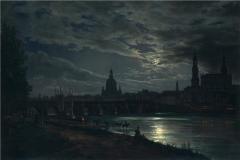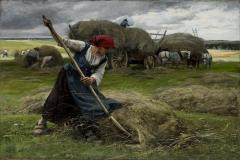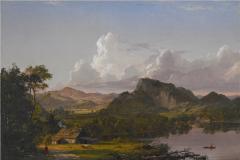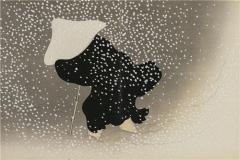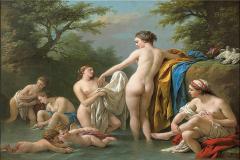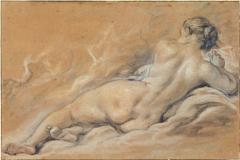画马画是没有不同于别的因为你应该基本上是想只是绘画一系列形状。就像画一幅肖像或图,这些形状就必须更加仔细地测量精度比一个景观。这幅画我第一次开始聚集在两个最大的形状,一个黑顶的帆布和其他光下面。这幅画中的元素是非常简单的,所以我选择不事先画出来,但去到一个区域,并制定绘画从那里,测量和比较每个新元素从先前禁区。虽然有点挑战性的工作超过一个图,这是我最喜欢的工作方式,如果我可以因为我爱绘画直接进入油漆和工作我的形状和边缘的一种。它更容易实现新的绘画这种方式,但如果你遇到图纸问题然后事情可以迅速恶化因为你之前的大型形状往往被淹没。
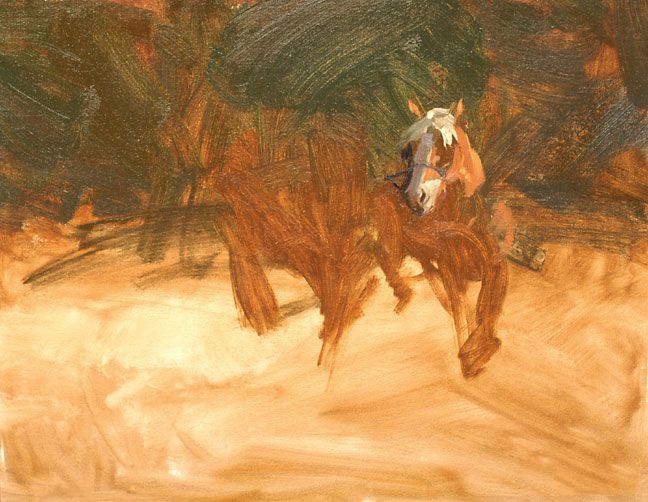
在上图中你可以看到第一个马的头新兴。
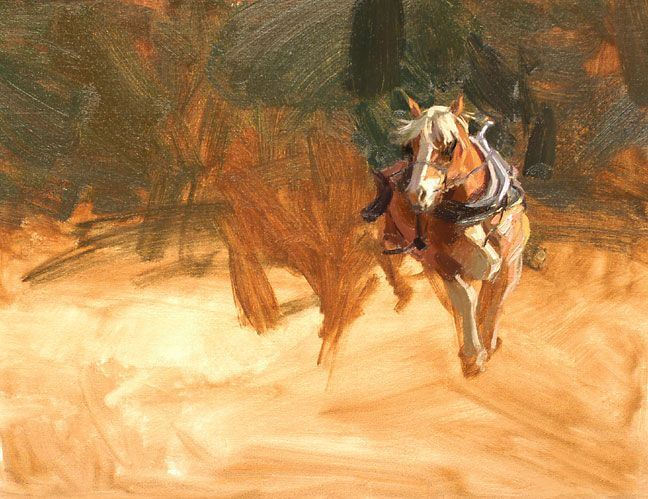
当我继续下到胸部和腿,我握住我的刷直上直下,当着我的照片参考,看每个形状的头。
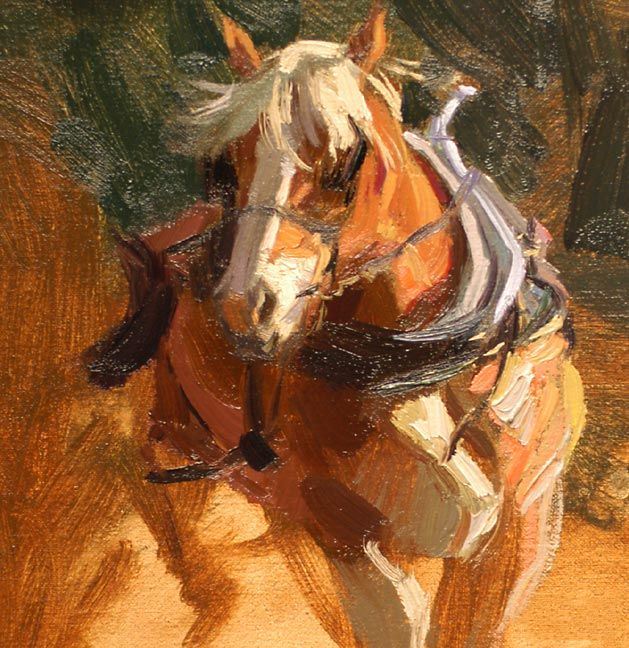
这是一个特写镜头,这样你可以看到一些形状你真的需要建议的形式。它有助于你的眼睛经常看你看你参考识别简单的模式,物质。尽量避免卷入太多的细节,特别是在一开始,否则你就会倾向于宽松的力量的整体。在这幅画我想传达的运动和结构的马在强烈的阳光下,不教一个解剖学课!你必须有自己的目标显然之前设置你的画开始因为这最初的灵感将决定一切——紧密或松散的你想漆,多么鲜艳或减弱,厚或薄等。
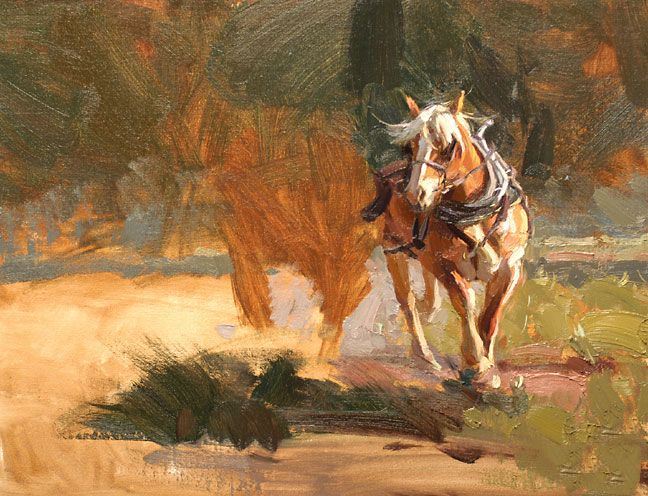
注意,每一个新的区域我到达,我第一次开始与最大的形状我可以——在这里我洗大形状的影子在草地上,在上面我将添加越来越小的形状。

你可以清楚地看到进展缓慢的重要性从一个形状下,不断与你所测量已经做了在这个阶段。一旦我有马在右边做,很容易把形式的第二匹马通过简单地比较,一切线水平与第一匹马。如果我试着去画两个这些马不使用这样的比较,我从来没有能够让他们彼此完全成正比。这就是为什么大量的人体素描在木炭是如此重要的绘画主题这样。一旦你练习你的图纸完全多年,技术方面的绘画成为第二天性,你几乎要有意识地思考——你的手和眼睛的测量只是一样容易我的手指去正确的关键在这个键盘。当我打字时,我在考虑我所说的而不是挣扎怎么说它。

因为这是一个阳光照射的场景我非常小心,我混合一些黄色和红色在我的蔬菜,这样他们不会偏离温暖和谐的阳光照射的场景。
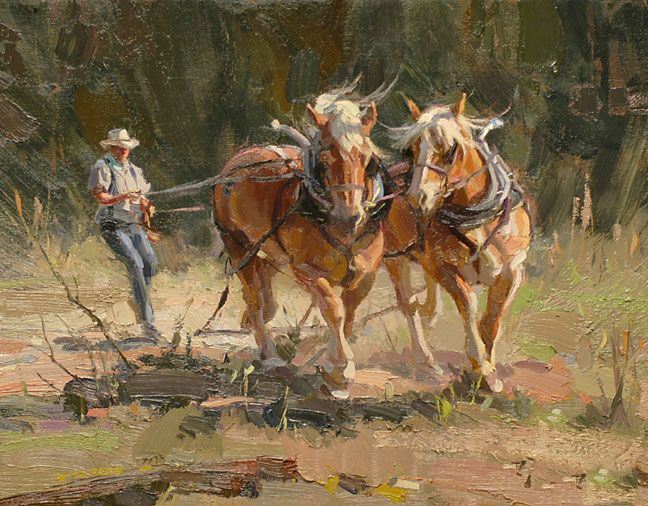
这里是最后的画!
“蒙大拿三重奏”油,14“×18”
原文如下:
Painting horses is no different than painting anything else since what you should essentially be thinking of is simply painting a series of shapes. Just as with painting a portrait or figure, these shapes just have to be more carefully measured for accuracy than a landscape. For this painting I first started by massing in the two largest shapes, one dark on the top of the canvas and the other light below. The elements in this painting were simple enough that I chose not to draw it out beforehand, but to go right into painting one area and work out from there, measuring and comparing each new element off the previously painted area. Though a little more challenging than working over a drawing, this is my favorite way to work if I can since I love painting directly into paint and working my shapes and edges one over the other. It is much easier to achieve fresh brushwork this way, but if you run into drawing problems then things can deteriorate quickly since your previous large shapes tend to get obliterated.
Above you can see the first horse's head emerging.
As I continue down to the chest and legs, I hold my brush straight up and down in front of my photo reference and see where each shape lines up with the head.
Here's a close-up so you can see how few shapes you really need to suggest the forms. It helps to squint your eyes often as you look at your reference to identify the simple patterns that matter. Try to keep from getting caught up in too many details, especially at the beginning, otherwise you'll tend to loose the power of the whole. In this painting I'm trying to convey movement and the structure of the horses in the strong sunlight, not to teach an anatomy lesson! You must have your goals clearly set before starting your painting since this initial inspiration will dictate everything -- how tightly or loose you want to paint, how colorful or subdued, thick or thin, etc.
Notice that each new area I reach, I first start out with the largest shape I can -- here I'm washing in the large shape of the shadow on the grass, over the top of which I will add the progressively smaller shapes.
You can clearly see the importance of going slow from one shape to the next and measuring constantly against what you've already done at this stage. Once I have the horse on the right done, it's very easy to place the forms of the second horse by simply comparing where everything lines up horizontally against the first horse. If I were to try drawing the two of these horses without using such comparisons, I'd never be able to get them exactly in proportion to each other. This is why a great deal of life drawing in charcoal is so important to painting a subject like this. Once you practice your drawing exclusively for years, that technical part of painting becomes second nature and you hardly have to consciously think about the measuring -- your hand and eye just do it as easily as my fingers go the right key on this keyboard. As I type, I'm thinking about what I'm saying rather than struggling with how to say it.
Because this is a sunlit scene I'm very careful that I'm mixing some yellow and red in my greens so that they don't deviate from the warm harmony of a sunlit scene.
And here's the final painting!
"Montana Trio" oil, 14" by 18"

